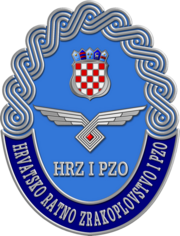Croatian Air Force
| Croatian Air Force and Air Defence | |
|---|---|
|
Croatian Air Force and Defence emblem
|
|
| Active | 1991 |
| Country | Croatia |
| Size | 1,454 personnel |
| H/Q | Pleso Air Base |
| Motto(s) | Hrvatskim nebom bdiju i plove (Croatian Sky they Guard and Fly) |
| Anniversaries | December 12 |
| Equipment | 96 aircraft |
| Engagements |
Croatian War of Independence: * Siege of Dubrovnik * Operation Maslenica * Operation Winter '94 * Operation Flash * Operation Storm Bosnian War * Operation Mistral 2 KFOR |
| Commanders | |
| Current commander |
brigadier general Miroslav Kovač |
| Notable commanders |
General Imra Agotić |
| Insignia | |
| Roundel |
 
|
| Fin Flash |
 
|
| Aircraft flown | |
| Fighter | MiG-21bis |
| Attack helicopter | OH-58D |
| Patrol | PC-9M, Bell 206B-3 |
| Trainer | Z 242L, PC-9M, MiG-21UM, Bell 206B-3 |
| Transport | Mi-8MTV-1, Mi-171Sh |
The Croatian Air Force and Air Defence (Croatian: Hrvatsko ratno zrakoplovstvo i protuzračna obrana) is a branch of the Croatian Armed Forces.
The Croatian Air Force as it is known today was established on 12 December 1991, during the Croatian War of Independence. After 2003, a large portion of the fleet was modernized or completely overhauled and the rest of the outdated fleet was retired. Croatia also acquired new-build transport helicopters, fire-fighting aircraft and basic training aircraft during this time. The planned acquisitions for additional fixed- and rotary-wing transports and fighter aircraft were, after repeated postponements, cancelled due to a difficult economic situation.
The primary role of the Croatian Air Force and Air Defence is securing the sovereignty of Croatian air space and providing air support to other services during joint operations. It operates the integrated Croatian Air Defence system. Other tasks include providing help in natural, humanitarian and technological disasters, search and rescue operations, and support to other government agencies.
Commanders of the Croatian Air Force since its establishment in 1991:
The core of the air force is a squadron of 12 modernized MiG-21bisD/UMD fighters. In 2003, a minor upgrade and an extensive overhaul were performed in Romania, incorporating navigation and communication elements of the Lancer standard to make them interoperable with NATO air forces. The aircraft received no upgrade to their weapons systems. Despite initial plans to replace the MiG-21 fleet with a multirole aircraft in 2013 (delayed from 2011 due to the financial crisis) and an official tender having been issued in 2008, ongoing budgetary constraints have resulted in an abandonment of these plans. As a cost-saving measure, a decision was made to again overhaul seven serviceable airframes already in service and supplement them with five additional airframes from Ukrspetsexport. This temporary measure will see the fleet remain in service only until 2019-2020.
Pilot training is conducted on two types of aircraft. During late 2007, five new Zlin 242L Aerobatic basic trainers were acquired in order to replace a fleet of seven old Utva 75s (four had already been retired previously). The deal was worth just under $2 million. An option for three additional basic trainers was considered but has not been exercised. The backbone of the training fleet, however, is built around 20 Pilatus PC-9M advanced trainers which also constitute the most numerous type of aircraft in Croatian service. These were ordered in 1997 (3 were former RAAF PC-9A examples converted to PC-9M standard immediately upon delivery) and entered full service a year later. The deal was worth around $100 million. They are also operated by the national aerobatic team called Krila Oluje / Wings of Storm. The fleet size and facilities at Zemunik airbase allow the Croatian Air Force to offer advanced pilot training to other countries but the lack of HUDs, HOTAS and hardpoints on Croatia's PC-9Ms, however, limits the usefulness of Croatia's advanced training programme. Such upgrades might be financially plausible once surplus PC-9Ms get sold. Nonetheless, on March 5, 2014, representatives of the Croatian Air Force signed an agreement with their partners from the Royal Air Force of Oman for the future training and education of 16 Omani pilots on the Croatian fleet of Pilatus PC-9Ms. The training itself started on March 10, is planned to be concluded by December 26, 2014 and will see each pilot log 150 flight hours during the ten-month period. As a cost-saving measure, the Croatian government has announced in its long-term defence plan that it plans to downsize the PC-9M fleet to a "suitable level" for the current air force fleet, substantially reduced since the mid-1990s. Consequently, six oldest units are offered for sale while the 14 remaining aircraft are due to remain active and possibly undergo an upgrade.
...
Wikipedia

